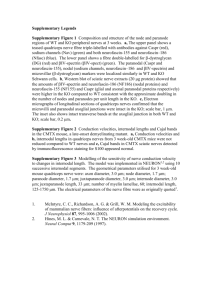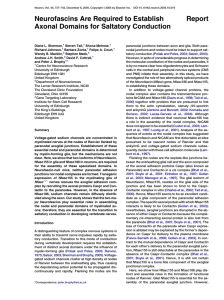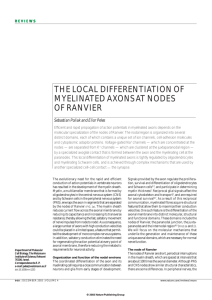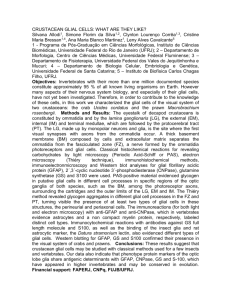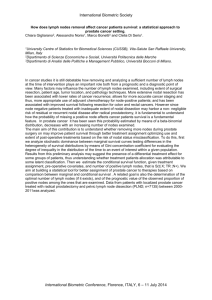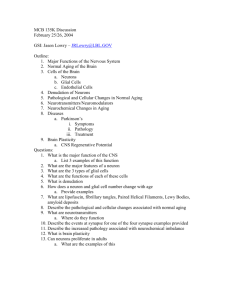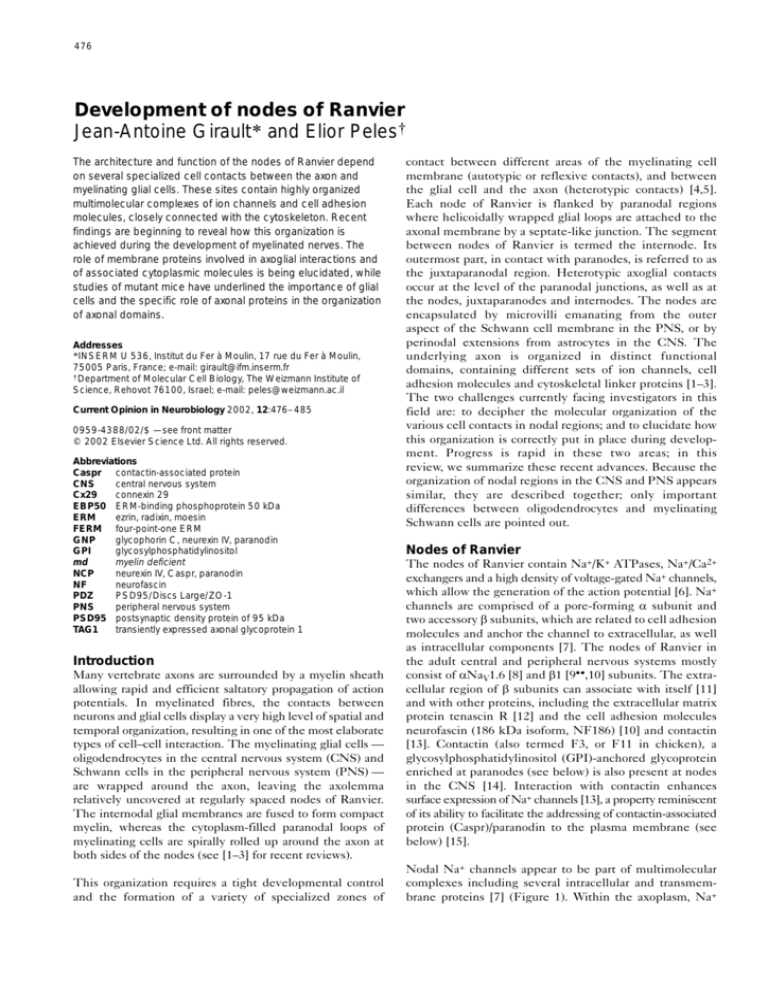
476
Development of nodes of Ranvier
Jean-Antoine Girault* and Elior Peles†
The architecture and function of the nodes of Ranvier depend
on several specialized cell contacts between the axon and
myelinating glial cells. These sites contain highly organized
multimolecular complexes of ion channels and cell adhesion
molecules, closely connected with the cytoskeleton. Recent
findings are beginning to reveal how this organization is
achieved during the development of myelinated nerves. The
role of membrane proteins involved in axoglial interactions and
of associated cytoplasmic molecules is being elucidated, while
studies of mutant mice have underlined the importance of glial
cells and the specific role of axonal proteins in the organization
of axonal domains.
Addresses
*INSERM U 536, Institut du Fer à Moulin, 17 rue du Fer à Moulin,
75005 Paris, France; e-mail: girault@ifm.inserm.fr
† Department of Molecular Cell Biology, The Weizmann Institute of
Science, Rehovot 76100, Israel; e-mail: peles@weizmann.ac.il
Current Opinion in Neurobiology 2002, 12:476–485
0959-4388/02/$ — see front matter
© 2002 Elsevier Science Ltd. All rights reserved.
Abbreviations
Caspr contactin-associated protein
CNS
central nervous system
Cx29
connexin 29
EBP50 ERM-binding phosphoprotein 50 kDa
ERM
ezrin, radixin, moesin
FERM four-point-one ERM
GNP
glycophorin C, neurexin IV, paranodin
GPI
glycosylphosphatidylinositol
md
myelin deficient
NCP
neurexin IV, Caspr, paranodin
NF
neurofascin
PDZ
PSD95/Discs Large/ZO-1
PNS
peripheral nervous system
PSD95 postsynaptic density protein of 95 kDa
TAG1
transiently expressed axonal glycoprotein 1
Introduction
Many vertebrate axons are surrounded by a myelin sheath
allowing rapid and efficient saltatory propagation of action
potentials. In myelinated fibres, the contacts between
neurons and glial cells display a very high level of spatial and
temporal organization, resulting in one of the most elaborate
types of cell–cell interaction. The myelinating glial cells —
oligodendrocytes in the central nervous system (CNS) and
Schwann cells in the peripheral nervous system (PNS) —
are wrapped around the axon, leaving the axolemma
relatively uncovered at regularly spaced nodes of Ranvier.
The internodal glial membranes are fused to form compact
myelin, whereas the cytoplasm-filled paranodal loops of
myelinating cells are spirally rolled up around the axon at
both sides of the nodes (see [1–3] for recent reviews).
This organization requires a tight developmental control
and the formation of a variety of specialized zones of
contact between different areas of the myelinating cell
membrane (autotypic or reflexive contacts), and between
the glial cell and the axon (heterotypic contacts) [4,5].
Each node of Ranvier is flanked by paranodal regions
where helicoidally wrapped glial loops are attached to the
axonal membrane by a septate-like junction. The segment
between nodes of Ranvier is termed the internode. Its
outermost part, in contact with paranodes, is referred to as
the juxtaparanodal region. Heterotypic axoglial contacts
occur at the level of the paranodal junctions, as well as at
the nodes, juxtaparanodes and internodes. The nodes are
encapsulated by microvilli emanating from the outer
aspect of the Schwann cell membrane in the PNS, or by
perinodal extensions from astrocytes in the CNS. The
underlying axon is organized in distinct functional
domains, containing different sets of ion channels, cell
adhesion molecules and cytoskeletal linker proteins [1–3].
The two challenges currently facing investigators in this
field are: to decipher the molecular organization of the
various cell contacts in nodal regions; and to elucidate how
this organization is correctly put in place during development. Progress is rapid in these two areas; in this
review, we summarize these recent advances. Because the
organization of nodal regions in the CNS and PNS appears
similar, they are described together; only important
differences between oligodendrocytes and myelinating
Schwann cells are pointed out.
Nodes of Ranvier
The nodes of Ranvier contain Na+/K+ ATPases, Na+/Ca2+
exchangers and a high density of voltage-gated Na+ channels,
which allow the generation of the action potential [6]. Na+
channels are comprised of a pore-forming α subunit and
two accessory β subunits, which are related to cell adhesion
molecules and anchor the channel to extracellular, as well
as intracellular components [7]. The nodes of Ranvier in
the adult central and peripheral nervous systems mostly
consist of αNaV1.6 [8] and β1 [9••,10] subunits. The extracellular region of β subunits can associate with itself [11]
and with other proteins, including the extracellular matrix
protein tenascin R [12] and the cell adhesion molecules
neurofascin (186 kDa isoform, NF186) [10] and contactin
[13]. Contactin (also termed F3, or F11 in chicken), a
glycosylphosphatidylinositol (GPI)-anchored glycoprotein
enriched at paranodes (see below) is also present at nodes
in the CNS [14]. Interaction with contactin enhances
surface expression of Na+ channels [13], a property reminiscent
of its ability to facilitate the addressing of contactin-associated
protein (Caspr)/paranodin to the plasma membrane (see
below) [15].
Nodal Na+ channels appear to be part of multimolecular
complexes including several intracellular and transmembrane proteins [7] (Figure 1). Within the axoplasm, Na+
Development of nodes of Ranvier Girault and Peles
477
Figure 1
Schematic organization of nodal regions in
peripheral nerves. The node is surrounded by
Schwann cell microvilli, which contain ERMs
and EBP50. These ERMs may provide a
connection to actin microfilaments. The nature
of the transmembrane protein(s) thought to
interact with axonal proteins is not known (?).
In the axon, two cell adhesion molecules,
NF186 and NrCAM are anchored to ankyrin
G, as are the Na+ channels. βIV spectrin is
also associated with ankyrin G. Syntenin-1
can bind to NF186 by a PDZ domain.
However, it is not yet known whether it is
present at nodes of Ranvier. Additional
proteins enriched in nodal axolemma include
the Na+/K+ ATPase and the Na+/Ca2+
exchanger. Several extracellular matrix
proteins are enriched at nodes of Ranvier,
including tenascin R, Bral-1, and proteoglycan
NG2, as well as phosphacan and versican V2.
At CNS nodes, the axonal proteins also
include contactin; Schwann cells microvilli are
replaced by astrocyte perinodal extensions.
Fibronectin type III repeats are shown as red
boxes, Ig domains as blue circles, PDZ
domains as indented orange circles, and
FERM domain as an orange oval.
Schwann cell
microvillus
EBP-50
Actin cytoskeleton
ERM
NG2
?
Bral-1
NF186
Phosphacan
Versican V2
NrCAM
Tenascin-R
Na+ channel
β
Na+/K+ ATPase Na+/Ca2+ exchanger
α
Syntenin-1
Nodal axoplasm
Ankyrin G
βIV spectrin
Actin cytoskeleton
Current Opinion in Neurobiology
channels are associated with ankyrin G, which belongs to a
family of intracellular adaptor proteins involved in targeting membrane proteins to specialized domains. This
association is possibly mediated by the β subunit of the
Na+ channel [11] or, as suggested recently, directly by its
α subunit [16•]. Ankyrin is also bound to βIV spectrin, a
spectrin isoform enriched at nodes of Ranvier and axon
initial segments [17,18••]. The intracellular carboxyl
(C)-terminal region of NrCAM and NF186, two cell adhesion
molecules of the L1 family, highly enriched in nodal
regions, is associated with ankyrin G [19]. The C-terminus
of NF186 also interacts with syntenin-1, a multifunctional
adaptor protein with two PDZ (PSD95/Discs Large/ZO-1)
domains [20]. NrCAM is capable of associating with, and
clustering specifically NF186 [21•]. Thus, nodal proteins
appear to form a meshwork of interacting components, in
which transmembrane proteins are associated directly and
through intracellular adaptor proteins (Figure 1).
Nodal multimolecular complexes may be further stabilized
by binding to extracellular matrix components present at
the nodes, including tenascin R [12,22–24], NG2 proteoglycan [25], phosphacan, versican V2, and the brainspecific hyaluronan-binding protein Bral1 [26]. Schwann
cell microvilli contain ezrin, radixin, moesin (ERM) proteins
and an associated PDZ domain-containing protein, ERMbinding phosphoprotein 50 kDa (EBP50) [27••,28•]. ERM
proteins provide a regulated membrane anchoring mechanism
for actin microfilaments, which are also enriched in
microvilli [29]. It seems likely that these proteins interact
with still unidentified transmembrane component(s) at the
tip of the microvilli that may bind axonal protein complexes
at the nodes.
Paranodal septate-like junction
At the paranodes, the glial loops are tightly attached to the
axolemma through a septate-like junction. The two membranes are separated by a narrow (2.5–3 nm) extracellular
space interrupted by septa interconnected with the
cytoskeleton of glial loops and axons [30]. Freeze fracture
analysis revealed that the paranodal junction appears
formed by superimposed rows of intramembranous particles,
regularly arranged in the glial and axonal membranes [31].
Two proteins are highly enriched in the paranodal axolemma:
Caspr/paranodin [32,33] and contactin [14]. Caspr/paranodin
belongs to a distinct subgroup of the neurexin superfamily,
termed NCP (neurexin IV, Caspr, paranodin), which
includes five different Caspr genes in humans
(Caspr1–Caspr5) [32,34–36], as well as neurexin-IV and
axotactin in Drosophila melanogaster [37,38]. The association
with contactin is necessary for the addressing of
Caspr/paranodin to the plasma membrane in transfected
cells [15] and its targeting to the axon in vivo [14].
Knockout mice lacking Caspr/paranodin or contactin
display ataxia, motor deficits and a dramatically reduced
nerve conduction velocity [39••,40••]. In these mutants,
478
Neuronal and glial cell biology
Figure 2
Figure 3
Glial cytoplasm
Glial paranodal loop
Cx 29 hemichannel
NF155
TAG1
Caspr/paranodin
Caspr2
Contactin
TAG1 ?
K+ channel
4.1B
4.1B
Actin cytoskeleton
PDZ protein?
Actin cytoskeleton
Paranodal axoplasm
Current Opinion in Neurobiology
PSD 95
Juxtaparanodal axoplasm
Current Opinion in Neurobiology
Schematic organization of paranodal regions. The main components of
paranodal axolemma are Caspr/paranodin associated with
contactin/F3, a GPI-anchored glycoprotein. This complex interacts
with a cell adhesion molecule of glial paranodal loops, NF155. The
intracellular region of Caspr/paranodin interacts with the FERM
domain of protein 4.1B, through a juxtamembrane sequence, the GNP
motif. Protein 4.1B provides a potential link with actin microfilaments.
Fibronectin type III repeats are shown as red boxes, Ig domains as
blue circles, EGF domains as green circles, laminin G domains as blue
boxes, fibrinogen domain as a red oval, factor VIII/discoidin domain as
a yellow oval, and FERM domain as an orange oval.
the ultrastructure of the paranodes is severely altered: the
glial paranodal loops are disorganized, the gap between
glial and axonal membranes is increased and the electrondense material forming the septa in wild-type mice is
absent [39••,40••]. The simplest explanation of these findings is that Caspr/paranodin and contactin are essential
components of the paranodal macromolecular complexes
required for the tight attachment of the two membranes.
The paranodal loops of oligodendrocytes and Schwann
cells contain the 155 kDa splice isoform of neurofascin
(NF155) [41]. Given that the localization of Caspr/paranodin,
contactin and NF155 at the paranodes is interdependent
[39••,40••,42•] and because NF155 binds to the
Caspr–contactin complex [43•], it is very likely that these
three proteins form the core of the axoglial cell adhesion
apparatus (Figure 2).
Schematic organization of juxtaparanodal regions. The juxtaparanodal
axolemma contains Kv1.1 and Kv1.2 K+ channels and Caspr2,
a protein closely related to Caspr/paranodin. These proteins are
associated through an as yet unidentified PDZ domain-containing
protein (?). PSD95, another PDZ domain-containing protein (or a
closely related protein), is enriched at juxtaparanodes but its partners
are not known. The Caspr2 intracellular region can associate with
protein 4.1B, which provides a link to the actin cytoskeleton. TAG1,
a GPI-anchored glycoprotein closely related to contactin/F3, is also
enriched at the juxtaparanodes. Although TAG1 is enriched in glial
membranes, it is also possibly present on neuronal membranes
(as indicated by a gray shading) and could be involved in cis or trans
associations with Caspr2, or in trans homophilic interactions with itself.
Cx29 is located in the glial membrane where it may form functional
hemichannels. Fibronectin type III repeats are shown as red boxes,
Ig domains as blue circles, EGF domains as green circles, laminin
G domains as blue boxes, fibrinogen domain as a red oval, factor
VIII/discoidin domain as a yellow oval, PDZ domains as orange
indented circles, SH3 domain as an orange indented box, guanylate
kinase domain as an orange rectangle, and FERM domain as an
orange oval.
An important feature of paranodal junctions is their tight
association with the cytoskeleton in both glial loops and
the axoplasm [30]. On the axonal side, the short intracellular
domain of Caspr/paranodin provides a site of anchorage
for cytoskeleton-associated proteins, through a sequence
conserved in glycophrin C, neurexin IV, paranodin (GNP)
motif [44]. This motif, now identified in many other
Development of nodes of Ranvier Girault and Peles
proteins, is a binding site for the four-point-one ERM
(FERM) domain of protein 4.1 [32]. Among the isoforms of
protein 4.1, encoded by four different genes in mammals,
type II, or protein 4.1B, is concentrated at paranodes and
juxtaparanodes [42•,45]. Protein 4.1B binds to the GNP motif
of Caspr/paranodin in vitro and the two proteins coimmunoprecipitate from brain extracts [46••] (N Denisenko,
JA Girault, unpublished data). Because protein 4.1B has a
conserved actin–spectrin-binding domain, it may associate
directly the transmembrane protein complexes to the axonal
cortical cytoskeleton (Figure 2). A remarkable feature of
paranodal septate-like junctions is their morphological and
molecular similarity with invertebrate septate junctions,
well characterized in Drosophila. In these, neurexin IV, the
Drosophila homologue of Caspr/paranodin [37], is colocalized
with D-contactin (C Faivre-Sarrailh, personal communication)
and recruits the protein 4.1 homolog coracle [47].
The juxtaparanodal regions
The Shaker-type K+ channels, Kv1.1, Kv1.2 and their
Kvβ2 subunit are enriched at the juxtaparanodal ends of
the internodal axolemma [48]. Caspr2, a protein that
displays a 45% amino acid identity with Caspr/paranodin, is
enriched in the juxtaparanodal axolemma and is associated
with K+ channels, presumably through a PDZ domaincontaining protein [34] (Figure 3). Although such a protein,
postsynaptic density protein of 95kDa (PSD95), has been
reported to coimmunoprecipitate and colocalize with Kvβ2
in paranodal regions [50•], it does not interact with Caspr2
[36]; Caspr2 is still associated with K+ channels in PSD95
mutant mice (MN Rasband, personal communication),
suggesting that other PDZ-containing protein(s) exist at this
site. In addition, similarly to Caspr/paranodin, Caspr2
contains an intracellular GNP motif and directly interacts
with 4.1B found at the juxtaparanodes [42•,45,46••]. Transient
axonal glycoprotein 1 (TAG1), a GPI-anchored cell adhesion
molecule related to contactin, expressed in Schwann cells,
oligodendrocytes and neurons, is highly enriched in the
juxtaparanodal region [50•]. Finally, the juxtaparanodal glial
membrane contains connexin 29 (Cx29), a gap junction
protein that may be capable of forming functional
hemichannels, possibly involved in K+ clearance [51•].
Formation of the nodal environs
The differentiation of the nodal regions into the distinct
domains seen in the adult nervous system takes place g
radually during myelination, and can be grossly divided into
distinct coordinated stages: the formation of nodal clusters,
which occurs concurrently with, or slightly precedes that of
the paranodal junctions, followed by concentration of
juxtaparanodal components. Several recent studies using a
variety of spontaneous and targeted mutations in mice have
demonstrated the essential role of myelinating cells in the
formation of distinct axonal domains as detailed below.
Localization of Na+ channels at the nodes
Na+ channels are clustered at early stages during development adjacent to the cellular processes of Schwann cells or
479
oligodendrocytes, suggesting that these clusters are pushed
towards the presumptive nodes by the glial paranodal loops
(reviewed in [48,52]). However, although the formation of
nodal aggregates of ankyrin G and Na+ channels depends
on oligodendrocytes and coincides with the formation of
paranodal contacts [53], it occurs independently of the
clustering of Caspr/paranodin and does not require the
establishment of tight septate-like junctions [39••,40••,54].
This conclusion is also supported by studies of the
consequences of spontaneous mutations of the proteolipid
(plp) gene protein, which trigger a delayed cell death of
oligodendrocytes in the CNS of jimpy mice and myelin
deficient (md) rats [55•,56,57••]. In these animals, although
Caspr/paranodin and NF155 are not detected at paranodes,
the nodal aggregates of Na+ channels and ankyrin G are by
and large normally formed [55•,56,57••]. Moreover, the
nodal clusters persist even at times when oligodendrocytes
have disappeared. However, the requirement of glial
cells for Na+ channel clustering was demonstrated by the
early postnatal selective ablation of oligodendrocytes in
transgenic mice [58]. In these mice, no clustering of
ankyrin G or Na+ channel was visible, except in contact
with the rare spared oligodendrocyte [57••].
The nature of the glial molecule(s) responsible for the
clustering of nodal neuronal proteins is not known.
Experiments in the PNS suggest that a direct contact
between Schwann cells and the axon is required [59],
although clustering at a distance from Schwann cells has
been observed in nerves of dystrophic mice in vivo [60].
During myelination of dorsal root ganglia neurons by
Schwann cells in vitro, initial clusters of Na+ channels are
detected in association with ERM-positive microvilli
processes, suggesting the involvement of a still unknown
ERM-binding receptor in channel clustering [27••]. By
contrast, oligodendrocytes appear to secrete a soluble
factor sufficient to trigger regularly spaced axonal clustering
of NaV1.2α subunits, β2 subunits and ankyrin G in
cultured neurons [9••,61]. During normal development,
NaV1.2 is first accumulated at immature nodes and later
replaced by NaV1.6 as myelination proceeds [62••]. By
contrast, NaV1.2 predominates in shiverer mice, in which a
mutation of myelin basic protein severely impairs the
formation of compact myelin, indicating that myelination
regulates Na+ channel switching. Nevertheless, two recent
studies demonstrated the presence of NaV1.6 in the nodes
of md rats and jimpy mutant mice [55•,56], suggesting that
while inducing the initial NaV1.2 clusters, oligodendrocytes may initiate an intrinsic programme in the axon for
later channel switching.
βIV spectrin and, presumably, ankyrin G are essential for
the organization of Na+ channel nodal clusters [18••,63•].
In the PNS, the cell adhesion molecules NrCAM and
NF186 cluster first, followed by ankyrin G, and finally Na+
channels [64]. In the CNS, however, ankyrin G appears at
the nodes before clustering of NF186 and Na+ channels
[56]. This temporal succession suggests that adhesion
480
Neuronal and glial cell biology
Figure 4
(a)
Schwann cell
lateral loop
Schwann cell
microvilli
(b)
Axon
(c)
(d)
Paranode
Node
Na+ channel
(e)
NrCAM or NF186
Actin
Caspr/paranodin
-contactin
NF155
Ankyrin G
Caspr2
Juxtaparanode
Paranode
Node
TAG1
Protein 4.1B
β IV spectrin
K+ channel
PDZ-protein
Current Opinion in Neurobiology
molecules (NrCAM, NF186, or an as yet unidentified
receptor) recruit ankyrin G, which is responsible for the
aggregation of Na+ channels. This model is supported by
the inhibition of nodal clustering of Na+ channels and
ankyrin G in myelinating dorsal root ganglia cultures incubated
in the presence of NrCAM–Fc fusion protein [21•].
Development of nodes of Ranvier Girault and Peles
481
Figure 4 legend
Development of nodes of Ranvier in the PNS. (a–c) The first event
appears to be the accumulation of cell adhesion molecules such as
NF186 or NrCAM. This event is likely to be triggered by contact with
as yet unidentified glial molecules, presumably associated with
Schwann cells microvilli (a). The intracellular regions of these cell
adhesion molecules interact with ankyrin G, which serves as an anchor
for Na+ channels (b), which may also interact directly with glial
molecules through its β-subunit (see Figure 1). Simultaneously, the
periaxonal extension of the glial cell wraps around the axon, as shown
by the spiraling arrow in (a), giving rise to presumptive paranodal
regions, which become progressively packed towards the nodal
region, as shown by the straight arrow in (b,c). This lateral movement
along the axon contributes significantly to the overall formation of
nodes of Ranvier by allowing heminodes formed at the edges of
neighboring glial cells to fuse into complete nodes. Although glial cells
are essential for the organization of nodal and paranodal axonal
proteins, the identity of the first glial molecules interacting with axonal
proteins at paranodes is not known with certainty, as indicated by a
gray oval in (b,c). (d) Septate-like junctions form progressively at
paranodes with the enrichment of NF155 in glial paranodal loops,
coincident with the appearance of transverse bands. Following the
early differentiation of the nodal and paranodal regions, K+ channels,
Caspr2 and TAG1 accumulate in juxtaparanodal regions. This
accumulation, whose mechanism remains to be elucidated, coincides
with the formation of compact myelin. In mutants in which paranodal
septate-like junctions are altered, Caspr2 and K+ channels accumulate
in paranodal regions, adjacent to nodal clusters. (e) In mature nodal
regions, interactions with intracellular proteins appear essential for the
stability of all nodal regions. These interactions involve linker and
scaffolding proteins that associate transmembrane proteins between
themselves and to the cytoskeleton, including actin filaments. These
intracellular axonal proteins are essential for the enrichment and/or
stability of axonal proteins. In the CNS oligodendrocytes do not
possess microvilli, but appear capable to trigger the clustering of some
axonal proteins through secreted factor(s). The combined effects of
such factors with the subsequent lateral movements generated by the
wrapping of oligodendrocyte periaxonal extension could account for
the organization of CNS nodes of Ranvier.
The role of ankyrin G appears essential, because its
specific deletion in Purkinje cells prevents targeting and
accumulation of NrCAM, NF186, and Na+ channels in
axon initial segments [65]. Given the similarities between
the axonal components at Ranvier nodes and axonal initial
segments, it is likely that ankyrin G is also important in
nodal regions. Likewise, the accumulation of Na+ channels
and ankyrin G is dramatically reduced in axon initial
segments and nodes of Ranvier of βIV-spectrin-deficient
mice [18••], showing the importance of cytoskeletal stabilization for the enrichment of these proteins. Interestingly,
although the axonal proteins enriched at axon initial
segments and Ranvier nodes are similar, the determinism
of their clustering appears different, because initial segments
form normally in the absence of oligodendrocytes [57••].
Although extracellular matrix proteins could be good
candidates for the regulation of aggregation of axonal proteins,
it should be noted that in tenascin R knockout mice, even
if the axonal conduction velocities are decreased, the nodal
distribution of Na+ channels appears normal [66].
both proteins are essential for the formation of the tight
paranodal junction, and that their absence results in the
disappearance of the transverse bands (intercellular septa),
which are the hallmark of this axoglial contact [39••,40••].
Interestingly, accumulation of Caspr/paranodin slightly
precedes that of NF155 and the formation of septa [70•],
suggesting that NF155 may be responsible for the formation
of the septate-like axoglial junction rather than for the
initial concentration of Caspr/paranodin at paranodes.
Although the intracellular region of Caspr/paranodin is not
required for its targeting, it is essential for its stability, as
well as that of contactin at the paranodal junction, presumably
through its interaction with protein 4.1B [46••]. Thus,
Caspr/paranodin may serve as a ‘transmembrane scaffold’
that stabilizes the adhesion complex at the paranodal junction
by connecting it to axonal cytoskeletal components.
Development and maintenance of the paranodal junction
The presence of Caspr/paranodin at the paranodes and the
juxtamesaxon [32,67], as well as its appearance in a spiral
below the overlying turn of the paranodal loops that forms
during development [2], strongly suggest that its localization
in the axon is regulated by the overlying myelin sheath.
Analysis of several myelin mutant animals showed that the
continuous presence of normal oligodendrocytes is necessary
for the paranodal localization of Caspr/paranodin and
contactin [55•,56,57••]. Galactocerebrosides [42•,54] and
their sulfated derivative, sulfatide [68,69•], are critical for
the correct formation of paranodal axoglial junctions. In
mice lacking ceramide galactosyl-transferase, Caspr/paranodin,
contactin and NF155 do not accumulate at paranodes,
which exhibit morphological abnormalities including the
absence of septa [42•,54]. Generation of mice lacking
either Caspr/paranodin or contactin demonstrated that
Localization of Caspr2/K+ channel complexes in the
juxtaparanodal region
K+ channel accumulation is detected at relatively late
developmental stages, after the node of Ranvier is already
formed (reviewed in [48,52]). In the PNS, K+ channels and
Caspr2 are first detected at the nodes and then are relocated
to the adjacent juxtaparanodal region [42•,71]. In the CNS,
however, K+ channels are first concentrated in the juxtaparanodal region [53]. These differences suggest that both
active exclusion from the paranodes and direct axonal
targeting may be involved. Study of mutant mice in which
the paranodal enrichment of Caspr/paranodin and
contactin is lost, reveals the role of the paranodal junction
in providing a barrier that restricts the apparent movement
of juxtaparanodal proteins [39••,40••,42•,54,55•,57••]. In
these mutants, although the nodal clustering of Na+ channels
is minimally affected, K+ channels are mislocalized at the
paranodes instead of in the juxtaparanodal region.
Interestingly, K+ channels are also mislocalized along
myelinated axons of quivering mice, which carry a loss-offunction mutation in the βIV spectrin gene [72•]. This is
482
Neuronal and glial cell biology
particularly interesting in light of the observation that βIV
spectrin is exclusively localized at the nodes, suggesting
that all the nodal subdomains are closely linked through
the cortical cytoskeleton.
Is there a glial protein that binds (either directly or
indirectly) to K+ channels causing their lateral movement
towards the node? The recent identification of TAG1 at
juxtaparanodes makes it a likely candidate for such a function.
Its similarity with contactin (48% sequence identity),
suggests that TAG1 may associate with Caspr2. Such an
association may occur between axonal TAG1 and Caspr2
or between TAG1 present in the glial juxtaparanodal
membrane and axonal Caspr2 [50•]. Furthermore, given
that TAG1 interacts homophilically [73], its presence in
both the axonal and the glial membrane may result in the
formation of an adhesion complex consisting of a glial
TAG1 molecule and an axonal Caspr2/TAG1 heterodimer.
Conclusions: a working model for the
development of nodes of Ranvier
Recent results, together with previous findings and
hypotheses [2,3,52] allow the proposal of a simplified
scenario for the formation of nodal regions (Figure 4). The
first event triggered by myelinating glial cells is the
clustering of axonal adhesion proteins, such as NrCAM
and NF186, or possibly other molecules. In peripheral
nerves, in which Schwann cell extensions cover the nodal
region, this appears to require a direct cell–cell contact,
whereas in the CNS, where no microvilli abut the nodes,
clustering may be triggered in response to a soluble factor.
Whatever the nature of extracellular signals, recruitment of
ankyrin G, with its multiple protein binding sites, is very
probably a major step, allowing the clustering of Na+ channels
with NrCAM and NF186. The presence of βIV spectrin is
a critical factor for the stability of these clusters.
In addition, possible repulsive interactions between
components of the nodal axolemma and the paranodal glial
loops may also exist, helping to prevent paranodal loops
from invading the nodal territory. Heminodal clusters can
form in contact with one myelinating cell and, as wrapping
of the myelinating cell proceeds, be pushed towards the
neighboring heminode until they fuse to form a complete
node [52,71]. While the periaxonal extension of the myelinating cell rolls up around the axon, and compact myelin is
formed, the lateral loops of the glial cells become progressively compacted in the lateral direction to form the
paranodal region [2]. At this time Caspr/paranodin–contactin complexes in the axolemma interact with NF155
in the glial membrane to form septate-like junctions. The
precise and regular geometric organization of these
junctions strongly suggests that additional, presumably
intracellular, proteins provide a grid-like meshwork,
allowing a regular spacing of intercellular complexes. This
intracellular meshwork is likely to include protein 4.1B
and other associated proteins and to be connected with
axonal cytoskeleton. Thus, paranodal junctions anchor the
glial cell membrane to the axolemma, and serve as barriers
for stopping the apparent movement of juxtaparanodal
components. Although the precise mechanism of the
juxtaparanodal accumulation of K+ channels, Caspr2 and
TAG1 remains to be determined, in the PNS these
proteins are first detected at nodes, suggesting that they
undergo an exclusion mechanism from these regions.
In contrast to the markedly different functional properties of
the various nodal domains, their generation and maintenance
may involve a limited number of similar molecular mechanisms. Further identification of additional components of
these complexes and of their relationships will no doubt shed
light on the development of these fascinating structures.
Acknowledgements
Work from the authors’ laboratories cited in this review has been supported
by grants from the Institut National de la Santé et de la Recherche
Médicale, Fondation pour la Recherche Médicale, and Fondation
Schlumberger pour l’Enseignement et la Recherche (J-A Girault), National
Multiple Sclerosis Society, The Israel Science Foundation and the Dr Pearl
H Levine Foundation for Research in the Neurosciences (E Peles). E Peles
is Incumbent of the Madeleine Haas Russell Career Development Chair.
We thank all our colleagues who kindly shared some of their recent
unpublished results, and apologize to those whose contributions could not
be mentioned due to space limitations.
References and recommended reading
Papers of particular interest, published within the annual period of review,
have been highlighted as:
• of special interest
•• of outstanding interest
1.
Arroyo EJ, Scherer SS: On the molecular architecture of
myelinated fibers. Histochem Cell Biol 2000, 113:1-18.
2.
Pedraza L, Huang JK, Colman DR: Organizing principles of the
axoglial apparatus. Neuron 2001, 30:335-344.
3.
Peles E, Salzer JL: Molecular domains of myelinated axons.
Curr Opin Neurobiol 2000, 10:558-565.
4.
Scherer SS, Arroyo EJ: Recent progress on the molecular
organization of myelinated axons. J Peripher Nerv Syst 2002,
7:1-12.
5.
Spiegel I, Peles E: Cellular junctions of myelinated nerves.
Mol Memb Biol 2002, 19:95-101.
6.
Waxman SG, Ritchie JM: Molecular dissection of the myelinated
axon. Ann Neurol 1993, 33:121-136.
7.
Isom LL: The role of sodium channels in cell adhesion. Front Biosci
2002, 7:12-23.
8.
Caldwell JH, Schaller KL, Lasher RS, Peles E, Levinson SR: Sodium
channel Na(v)1.6 is localized at nodes of Ranvier, dendrites, and
synapses. Proc Natl Acad Sci USA 2000, 97:5616-5620.
9.
••
Kaplan MR, Cho MH, Ullian EM, Isom LL, Levinson SR, Barres BA:
Differential control of clustering of the sodium channels Na(v)1.2
and Na(v)1.6 at developing CNS nodes of Ranvier. Neuron 2001,
30:105-119.
This article provides evidence that oligodendrocytes secrete soluble proteic
factor(s) inducing clustering of Nav1.2 channels and ankyrin G in neurons in
culture. This clustering requires an intact actin cytoskeleton, protein synthesis
and vesicle trafficking, suggesting the involvement of a nodal-specific
transport mechanism.
10. Ratcliffe CF, Westenbroek RE, Curtis R, Catterall WA: Sodium
channel beta1 and beta3 subunits associate with neurofascin
through their extracellular immunoglobulin-like domain. J Cell
Biol 2001, 154:427-434.
11. Malhotra JD, Kazen-Gillespie K, Hortsch M, Isom LL: Sodium channel
beta subunits mediate homophilic cell adhesion and recruit
ankyrin to points of cell-cell contact. J Biol Chem 2000,
275:11383-11388.
Development of nodes of Ranvier Girault and Peles
12. Volkmer H, Zacharias U, Norenberg U, Rathjen FG: Dissection of
complex molecular interactions of neurofascin with axonin-1,
F11, and tenascin-R, which promote attachment and
neurite formation of tectal cells. J Cell Biol 1998,
142:1083-1093.
13. Kazarinova-Noyes K, Malhotra JD, McEwen DP, Mattei LN,
Berglund EO, Ranscht B, Levinson SR, Schachner M, Shrager P,
Isom LL et al.: Contactin associates with Na+ channels and
increases their functional expression. J Neurosci 2001,
21:7517-7525.
14. Rios JC, Melendez-Vasquez CV, Einheber S, Lustig M, Grumet M,
Hemperly J, Peles E, Salzer JL: Contactin-associated protein
(Caspr) and contactin form a complex that is targeted to the
paranodal junctions during myelination. J Neurosci 2000,
20:8354-8364.
15. Faivre-Sarrailh C, Gauthier F, Denisenko-Nehrbass N, Le Bivic A,
Rougon G, Girault JA: The GPI-anchored adhesion molecule
F3/contactin is required for surface transport of paranodin/caspr.
J Cell Biol 2000, 149:491-502.
16. Bouzidi M, Tricaud N, Giraud P, Kordeli E, Caillol G, Deleuze C,
•
Couraud F, Alcaraz G: Interaction of the Nav1.2a subunit of the
voltage-dependent sodium channel with nodal ankyrin G. J Biol
Chem 2002 277:28996-29004.
This paper shows a direct interaction between the α subunit of Nav1.2 and
ankyrin G, and challenges the role of the β subunit in anchoring the channel
to ankyrin G.
17.
Berghs S, Aggujaro D, Dirkx R Jr, Maksimova E, Stabach P,
Hermel JM, Zhang JP, Philbrick W, Slepnev V, Ort T et al.: Beta IV
spectrin, a new spectrin localized at axon initial segments and
nodes of Ranvier in the central and peripheral nervous system.
J Cell Biol 2000, 151:985-1002.
18. Komada M, Soriano P: βIV-spectrin regulates sodium channel
•• clustering through ankyrin-G at axon initial segments and nodes
of Ranvier. J Cell Biol 2002, 156:337-348.
This article reports that βIV spectrin knockout mice display a severe neurological phenotype, with a lack of clustering of ankyrin G and Nav1.6 sodium
channels at nodes of Ranvier and at axon initial segments. See also [72•].
19. Davis JQ, Lambert S, Bennett V: Molecular composition of the node
of Ranvier: identification of ankyrin-binding cell adhesion
molecules neurofascin (mucin+/third FNIII domain-) and
NrCAM at nodal axon segments. J Cell Biol 1996,
135:1355-1367.
20. Koroll M, Rathjen FG, Volkmer H: The neural cell recognition
molecule neurofascin interacts with syntenin-1 but not with
syntenin-2, both of which reveal self-associating activity. J Biol
Chem 2001, 276:10646-10654.
21. Lustig M, Zanazzi G, Sakurai T, Blanco C, Levinson SR, Lambert S,
•
Grumet M, Salzer JL: Nr-CAM and neurofascin interactions
regulate ankyrin G and sodium channel clustering at the node of
Ranvier. Curr Biol 2001, 11:1864-1869.
This study provides evidence for a direct interaction between NrCAM and
neurofascin extracellular domains and their role in node organization. The
authors also show that a soluble NrCAM–Ig chimera inhibited the accumulation of ankyrin G and sodium channels at nodes of Ranvier.
22. Bartsch U, Pesheva P, Raff M, Schachner M: Expression of janusin
(J1-160/180) in the retina and optic nerve of the developing and
adult mouse. Glia 1993, 9:57-69.
23. Srinivasan J, Schachner M, Catterall WA: Interaction of voltagegated sodium channels with the extracellular matrix molecules
tenascin-C and tenascin-R. Proc Natl Acad Sci USA 1998,
95:15753-15757.
24. Xiao ZC, Ragsdale DS, Malhotra JD, Mattei LN, Braun PE,
Schachner M, Isom LL: Tenascin-R is a functional modulator of
sodium channel beta subunits. J Biol Chem 1999,
274:26511-26517.
25. Martin S, Levine AK, Chen ZJ, Ughrin Y, Levine JM: Deposition of the
NG2 proteoglycan at nodes of Ranvier in the peripheral nervous
system. J Neurosci 2001, 21:8119-8128.
26. Oohashi T, Hirakawa S, Bekku Y, Rauch U, Zimmermann DR, Su WD,
Ohtsuka A, Murakami T, Ninomiya Y: Bral1, a brain-specific link
protein, colocalizing with the versican V2 isoform at the nodes of
Ranvier in developing and adult mouse central nervous systems.
Mol Cell Neurosci 2002, 19:43-57.
483
27.
••
Melendez-Vasquez CV, Rios JC, Zanazzi G, Lambert S, Bretscher A,
Salzer JL: Nodes of Ranvier form in association with ezrin-radixinmoesin (ERM)-positive Schwann cell processes. Proc Natl Acad
Sci USA 2001, 98:1235-1240.
The authors demonstrate the enrichment of ezrin and EBP50 in perinodal
Schwann cells processes in vivo and in cocultures of Schwann cells and
dorsal root ganglia neurons. Ezrin clusters colocalized with ankyrin G clusters
early on during development, providing direct evidence of a direct contact
between Schwann cells and axons during the organization of nodal regions.
See also [28•], which shows that moesin and radixin have a similar location.
28. Scherer SS, Xu T, Crino P, Arroyo EJ, Gutmann DH: Ezrin, radixin,
•
and moesin are components of Schwann cell microvilli. J Neurosci
Res 2001, 65:150-164.
See annotation to [27••].
29. Trapp BD, Andrews SB, Wong A, O’Connell M, Griffin JW:
Co-localization of the myelin-associated glycoprotein and the
microfilament components, F-actin and spectrin, in Schwann cells
of myelinated nerve fibres. J Neurocytol 1989, 18:47-60.
30. Ichimura TE: Three-dimensional fine structure of cytoskeletalmembrane interactions at nodes of Ranvier. J Neurocytol 1991,
20:667-681.
31. Wiley CA, Ellisman MH: Rows of dimeric-particles within the
axolemma and juxtaposed particles within glia, incorporated into
a new model for the paranodal glial-axonal junction at the node of
Ranvier. J Cell Biol 1980, 84:261-280.
32. Menegoz M, Gaspar P, Le Bert M, Galvez T, Burgaya F, Palfrey C,
Ezan P, Amos F, Girault JA: Paranodin, a glycoprotein of neuronal
paranodal membranes. Neuron 1997, 19:319-331.
33. Einheber S, Zanazzi G, Ching W, Scherer S, Milner TA, Peles E,
Salzer JL: The axonal membrane protein Caspr, a homologue of
neurexin IV, is a component of the septate-like paranodal
junctions that assemble during myelination. J Cell Biol 1997,
139:1495-1506.
34. Poliak S, Gollan L, Martinez R, Custer A, Einheber S, Salzer JL,
Trimmer JS, Shrager P, Peles E: Caspr2, a new member of the
neurexin superfamily, is localized at the juxtaparanodes of
myelinated axons and associates with K+ channels. Neuron 1999,
24:1037-1047.
35. Peles E, Nativ M, Lustig M, Grumet M, Schilling J, Martinez R,
Plowman GD, Schlessinger J: Identification of a novel contactinassociated transmembrane receptor with multiple domains
implicated in protein-protein interactions. EMBO J 1997,
16:978-988.
36. Spiegel I, Salomon D, Erne B, Schaeren-Wiemers N, Peles E: Caspr3
and Caspr4, two novel members of the Caspr family are
expressed in the nervous system and interact with PDZ domains.
Mol Cell Neurosci 2002, 20:283-297.
37.
Baumgartner S, Littleton JT, Broadie K, Bhat MA, Harbecke R,
Lengyel JA, Chiquet-Ehrisman R, Prokop A, Bellen HJ: A Drosophila
neurexin is required for septate junction and blood-nerve barrier
formation and function. Cell 1996, 87:1059-1068.
38. Yuan LL, Ganetzky B: A glial-neuronal signaling pathway revealed
by mutations in a neurexin-related protein. Science 1999,
283:1343-1345.
39. Bhat MA, Rios JC, Lu Y, Garcia-Fresco GP, Ching W, Martin MS, Li J,
•• Einheber S, Chesler M, Rosenbluth J et al.: Axon-glia interactions
and the domain organization of myelinated axons requires
neurexin IV/Caspr/paranodin. Neuron 2001, 30:369-383.
Here, the generation of Caspr/paranodin deficient mice demonstrates the
importance of this protein in the formation and structure of paranodal
septate-like junctions. Homozygous knockout mice have a severe neurological
phenotype starting at postnatal day 11 and most die at weaning. Sciatic
nerve conduction velocity is decreased and the ultrastructure of paranodes
is severely altered in both the CNS and the PNS. The results also show that
Caspr/paranodin is necessary for the restriction of K+ channels to the
juxtaparanodal region.
40. Boyle ME, Berglund EO, Murai KK, Weber L, Peles E, Ranscht B:
•• Contactin orchestrates assembly of the septate-like junctions at
the paranode in myelinated peripheral nerve. Neuron 2001,
30:385-397.
This paper demonstrates the close functional association of contactin and
Caspr/paranodin in vivo. In contactin knockout mice, Caspr/paranodin was
absent from axons and paranodes and was retained in cell bodies, showing
the importance of the interaction between the two proteins for their proper
targeting in vivo (note that, conversely, contactin was not detected at
484
Neuronal and glial cell biology
paranodes of Caspr/paranodin knockout mice [39••]). The morphological
and functional phenotype of contactin mutant mice in central and peripheral
neuronal fibers was similar to that of Caspr/paranodin knockout mice.
Because both proteins were absent from paranodes in either mutant, it is not
possible to identify their specific role in these regions.
41. Tait S, Gunn-Moore F, Collinson JM, Huang J, Lubetzki C, Pedraza L,
Sherman DL, Brophy PJ: An oligodendrocyte cell adhesion
molecule at the site of assembly of the paranodal axo-glial
junction. J Cell Biol 2000, 150:657-666.
42. Poliak S, Gollan L, Salomon D, Berglund EO, Ohara R, Ranscht B,
•
Peles E: Localization of Caspr2 in myelinated nerves depends on
axon-glia interactions and the generation of barriers along the
axon. J Neurosci 2001, 21:7568-7575.
This paper provides a detailed study of the localization of Caspr/paranodin
and Caspr2 in wild-type and various mutant mice, showing that their
distribution is mutually exclusive, and suggesting their possible role in the
generation of ‘barriers’ along the axon.
43. Charles P, Tait S, Faivre-Sarrailh C, Barbin G, Gunn-Moore F,
•
Denisenko-Nehrbass N, Guennoc AM, Girault JA, Brophy PJ,
Lubetzki C: Neurofascin is a glial receptor for the
paranodin/Caspr-contactin axonal complex at the axoglial
junction. Curr Biol 2002, 12:217-220.
This paper shows that NF155 associates with the Caspr/paranodin and
contactin complex. Surprisingly, the addition of a soluble NF155 protein to
cocultures of neurons and oligodendrocytes inhibits myelination, suggesting
a possible role for NF155 in myelination.
44. Girault JA, Labesse G, Mornon J-P, Callebaut I: The FAKs and JAKs
play in the 4.1 band: a superfamily of band 4.1 domains important
for cell structure and signal transduction. Mol Med 1998,
4:751-769.
55. Arroyo EJ, Xu T, Grinspan J, Lambert S, Levinson SR, Brophy PJ,
•
Peles E, Scherer SS: Genetic dysmyelination alters the molecular
architecture of the nodal region. J Neurosci 2002, 22:1726-1737.
This paper provides a careful and detailed study of the distribution of nodal,
paranodal and juxtaparanodal proteins in md rats, which carry a mutation of
the plp protein. The alterations in md rats are similar to those observed in
jimpy mice, which also have a plp mutation [57••].
56. Jenkins SM, Bennett V: Developing nodes of Ranvier are defined
by ankyrin-G clustering and are independent of paranodal
axoglial adhesion. Proc Natl Acad Sci USA 2002, 99:2303-2308.
57.
••
Mathis C, Denisenko-Nehrbass N, Girault JA, Borrelli E: Essential
role of oligodendrocytes in the formation and maintenance of
central nervous system nodal regions. Development 2001,
128:4881-4890.
The authors use a transgenic mouse line that expresses herpes virus
thymidine kinase in oligodendrocytes [58]. Treatment of these mice with a
nucleoside analogue destroys the oligodendrocyte precursors that are still
dividing. Early ablation of oligodendrocytes resulted in the absence of differentiation of nodal regions in the corpus callossum, underlining the
importance of the myelinating glial cells in the organization of nodal domains
in the CNS. This paper also describes the consequences of the mutation of
the proteolipid protein plp in jimpy mice, which results in a severe dysmyelination, abnormal paranodal junctions, and delayed oligodendrocyte cell
death. Although nodal markers appear normal in these mice (as in md rats
[55•]), Caspr/paranodin is absent from paranodes, whereas K+ channels are
clustered in direct contact with nodes. The comparison of the two types of
mutant mice allows the authors to distinguish distinct roles of oligodendrocytes at different stages of the formation of nodal regions.
58. Mathis C, Hindelang C, LeMeur M, Borrelli E: A transgenic mouse
model for inducible and reversible dysmyelination. J Neurosci
2000, 20:7698-7705.
45. Ohara R, Yamakawa H, Nakayama M, Ohara O: Type II brain 4.1
(4.1B/KIAA0987), a member of the protein 4.1 family, is localized
to neuronal paranodes. Brain Res Mol Brain Res 2000, 85:41-52.
59. Ching W, Zanazzi G, Levinson SR, Salzer JL: Clustering of neuronal
sodium channels requires contact with myelinating Schwann
cells. J Neurocytol 1999, 28:295-301.
46. Gollan L, Sabanay H, Poliak S, Berglund SR, Ranscht B, Peles E:
•• Retention of a cell adhesion complex at the paranodal junction
requires the cytoplasmic region of Caspr. J Cell Biol 2002,
157:1247-1256.
Here, Gollan et al. demonstrate that the extracellular region of Caspr/paranodin
is sufficient to direct it to the paranodal junction. However, retention of the
Caspr/paranodin and contactin complex at this site requires its intracellular
domain, which interacts with protein 4.1B.
60. Deerinck TJ, Levinson SR, Bennett GV, Ellisman MH: Clustering of
voltage-sensitive sodium channels on axons is independent of
direct Schwann cell contact in the dystrophic mouse. J Neurosci
1997, 17:5080-5088.
47.
62. Boiko T, Rasband MN, Levinson SR, Caldwell JH, Mandel G,
•• Trimmer JS, Matthews G: Compact myelin dictates the differential
targeting of two sodium channel isoforms in the same axon.
Neuron 2001, 30:91-104.
These authors provide evidence for isoform switching of nodal Na+ channels
during development in vivo. They show that during development, Nav1.2 is
expressed first at nodes where it is later replaced by Nav1.6. In the adult,
Nav1.2 is found in unmyelinated fibers. In shiverer mice, which lack compact
myelin, this shift is severely altered.
Lamb RS, Ward RE, Schweizer L, Fehon RG: Drosophila Coracle,
a member of the protein 4.1 superfamily, has essential structural
functions in the septate junctions and developmental functions in
embryonic and adult epithelial cells. Mol Biol Cell 1998,
9:3505-3519.
48. Rasband MN, Trimmer JS: Developmental clustering of ion
channels at and near the node of Ranvier. Dev Biol 2001,
236:5-16.
49. Baba H, Akita H, Ishibashi T, Inoue Y, Nakahira K, Ikenaka K:
Completion of myelin compaction, but not the attachment of
oligodendroglial processes triggers K(+) channel clustering.
J Neurosci Res 1999, 58:752-764.
50. Traka M, Dupree JL, Popko B, Karagogeos D: The neuronal
•
adhesion protein TAG-1 is expressed by Schwann cells and
oligodendrocytes and is localized to the juxtaparanodal region of
myelinated fibers. J Neurosci 2002, 22:3016-3024.
These authors demonstrate the expression of TAG1 in myelinating glial cells
and its enrichment at juxtaparanodes.
51. Altevogt BM, Kleopa KA, Postma FR, Scherer SS, Paul DL: Cx29 is
•
uniquely distributed within myelinating glial cells of the central
and peripheral nervous systems. J Neurosci 2002, 22:6458-6470.
In this paper, the investigators demonstrate the presence of Cx29 in the glial
juxtaparanodal membrane. They further suggest that Cx29 may form hemichannels that could contribute to K+ ion removal from the periaxonal space.
52. Rasband MN, Shrager P: Ion channel sequestration in central
nervous system axons. J Physiol 2000, 525:63-73.
53. Rasband MN, Peles E, Trimmer JS, Levinson SR, Lux SE, Shrager P:
Dependence of nodal sodium channel clustering on paranodal
axoglial contact in the developing CNS. J Neurosci 1999,
19:7516-7528.
54. Dupree JL, Girault JA, Popko B: Axo-glial interactions regulate the
localization of axonal paranodal proteins. J Cell Biol 1999,
147:1145-1152.
61. Kaplan MR, Meyer-Franke A, Lambert S, Bennett V, Duncan ID,
Levinson SR, Barres BA: Induction of sodium channel clustering by
oligodendrocytes. Nature 1997, 386:724-728.
63. Jenkins SM, Bennett V: Ankyrin-G coordinates assembly of the
•
spectrin-based membrane skeleton, voltage-gated sodium
channels, and L1 CAMs at Purkinje neuron initial segments. J Cell
Biol 2001, 155:739-746.
Jenkins and Bennett demonstrate the requirement for ankyrin G in the
organization of axon initial segments. These results underline the important
role of ankyrin G in a region that has a high degree of homology with the
nodes of Ranvier.
64. Lambert S, Davis JQ, Bennett V: Morphogenesis of the node of
Ranvier: Co-clusters of ankyrin and ankyrin-binding integral
proteins define early developmental intermediates. J Neurosci
1997, 17:7025-7036.
65. Zhou D, Lambert S, Malen PL, Carpenter S, Boland LM, Bennett V:
Ankyrin G is required for clustering of voltage-gated Na channels
at axon initial segments and for normal action potential firing.
J Cell Biol 1998, 143:1295-1304.
66. Weber P, Bartsch U, Rasband MN, Czaniera R, Lang Y,
Bluethmann H, Margolis RU, Levinson SR, Shrager P, Montag D et al.:
Mice deficient for tenascin-R display alterations of the
extracellular matrix and decreased axonal conduction velocities in
the CNS. J Neurosci 1999, 19:4245-4262.
67.
Arroyo EJ, Xu YT, Zhou L, Messing A, Peles E, Chiu SY, Scherer SS:
Myelinating Schwann cells determine the internodal localization
of Kv1.1, Kv1.2, Kvbeta2, and Caspr. J Neurocytol 1999,
28:333-347.
Development of nodes of Ranvier Girault and Peles
68. Honke K, Hirahara Y, Dupree J, Suzuki K, Popko B, Fukushima K,
Fukushima J, Nagasawa T, Yoshida N, Wada Y et al.: Paranodal
junction formation and spermatogenesis require sulfoglycolipids.
Proc Natl Acad Sci USA 2002, 99:4227-4232.
69. Ishibashi T, Dupree JL, Ikenaka K, Hirahara Y, Honke K, Peles E,
•
Popko B, Suzuki K, Nishino H, Baba H: A myelin galactolipid,
sulfatide is essential for maintenance of ion channels on
myelinated axon but not essential for initial cluster formation.
J Neurosci 2002, 22:6507-6514.
Here, the previously reported phenotype of mice deficient in galactosylsulfamide transferase [68], which lack sulfatides, is studied in much more detail.
The alterations in the nodal regions of these mice are shown to be very
similar to those in mice deficient in both ceramides and sulfatides [54].
70. Marcus J, Dupree JL, Popko B: Myelin-associated glycoprotein and
•
myelin galactolipids stabilize developing axo-glial interactions.
J Cell Biol 2002, 156:567-577.
In this paper, a detailed morphological study of the role of galactolipids in the
formation of paranodal junctions is presented. The authors also study their
485
functional interaction with myelin-associated glycoprotein. This study
provides interesting clues about the development of the ultrastructural
features of paranodes.
71. Vabnick I, Novakovic SD, Levinson SR, Schachner M, Shrager P:
The clustering of axonal sodium channels during development
of the peripheral nervous system. J Neurosci 1996,
16:4914-4922.
72. Parkinson NJ, Olsson CL, Hallows JL, McKee-Johnson J, Keogh BP,
•
Noben-Trauth K, Kujawa SG, Tempel BL: Mutant beta-spectrin 4
causes auditory and motor neuropathies in quivering mice. Nat
Genet 2001, 29:61-65.
Here, the authors report the mislocalization of K+ channels in the absence of
nodal βIV spectrin. They suggest that the different nodal domains are
coupled through the cortical cytoskeleton.
73. Malhotra JD, Tsiotra P, Karagogeos D, Hortsch M: Cis-activation of
L1-mediated ankyrin recruitment by TAG-1 homophilic cell
adhesion. J Biol Chem 1998, 273:33354-33359.

